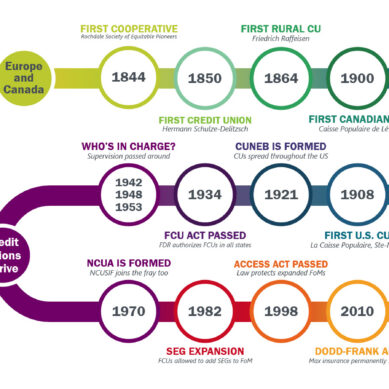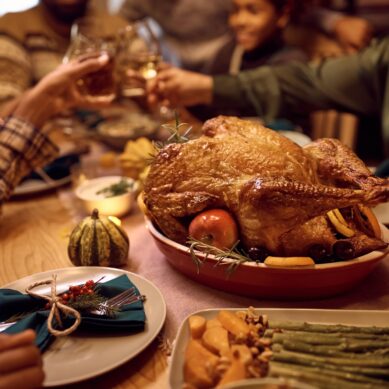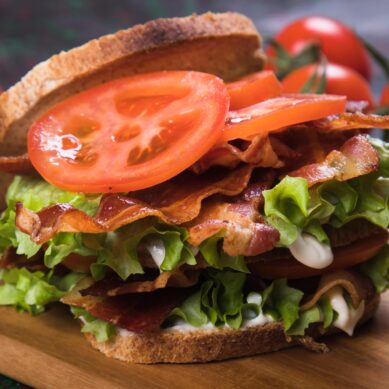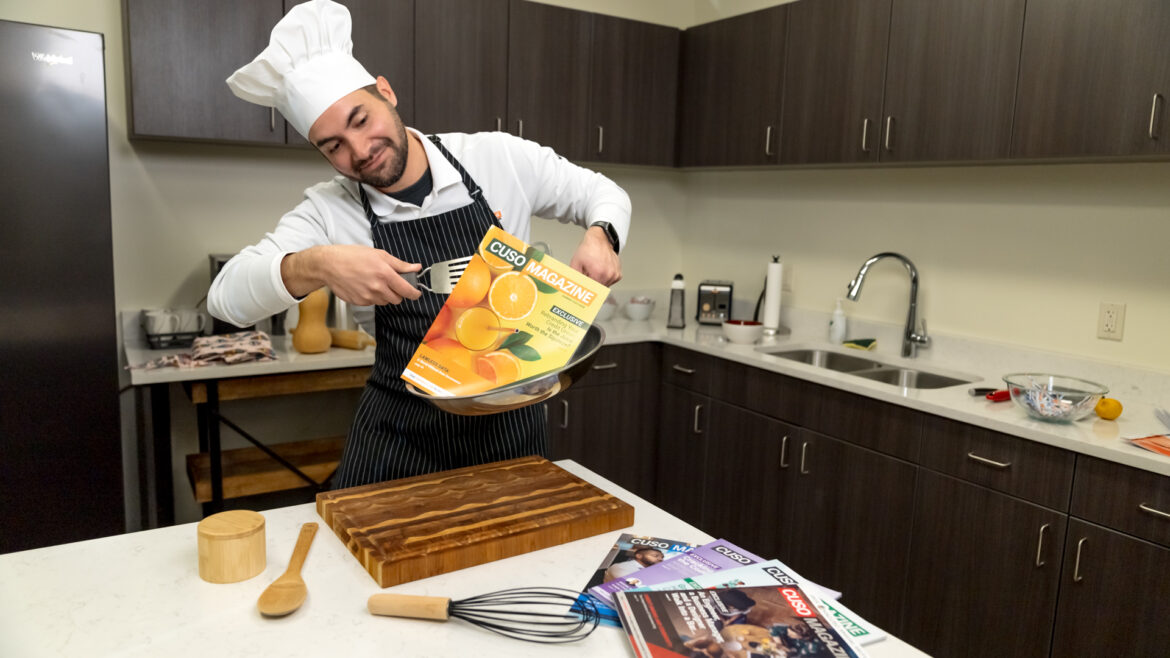Welcome back to another Cooking with CUSO Mag in which we learn about the world of credit unions and food—direct correlations need not apply.
Before we get to the recipe, one created out of a silly challenge, let’s take a look at the wider world of financial cooperatives and learn what they are like a continent away: Asia.
A look at financial cooperatives in Asia
The world of credit unions is expansive. Though we may be aware of their origins in Europe, today credit unions expand much further. In Asia, credit unions did not make their debut until the 1960s, but they were preceded by financial cooperatives introduced by the British colonial government in India and Sri Lanka more than 100 years ago. From there, they spread to the Philippines and Thailand.
Seeing an opportunity for credit unions to serve the financially disadvantaged, the Social Economic Life of of Asia introduced the concept of credit unions at a conference, laying the ground work for the growth to come. The first Asian credit union was formed in Korea in 1960.
From there, what was then the Credit Union National Association (CUNA) collaborated with the Philippine Credit Union League (now Philippine Federation of Credit Cooperatives) in 1961 to provide education and training to individuals from twelve nations, leading to the formation of the first credit unions in Taiwan (1963), Hong Kong (1964), Japan and Thailand (1965), Malaysia and Vietnam (1966), and Indonesia (1970).
The Asian Confederation of Credit Unions (ACCU) would later be formed in 1971 as delegates from nine countries came together to with the mission of helping the associated credit union leagues organize, expand, and improve credit unions in their respective nations. Shortly thereafter, the ACCU would be formally welcomed by the World Council of Credit Unions (WOCCU) as an affiliate member, giving access to a deeper level of training resources.
Since then, credit unions have exploded onto the scene in Asia. According to the Association of Asian Confederation of Credit Unions, the ACCU now represents more than 45,000 credit unions in 22 countries, with over 40 million members. While this represents roughly 1 percent of the total Asian population, it’s an impressive start with plenty of opportunity for Asian credit unions to serve the disadvantaged and unbanked.
In its efforts to expand and improve credit unions in Asia, the ACCU has taken a stepped approach to its own development, adding initiatives over the years. In the 70s it focused primarily on “Motivational” efforts, seeking to introduce credit unions to Asian countries, form federations within those countries, and help credit unions launch. In the 80s, they added the goal of leadership development to promote and educate new leaders. From 1993 to 2005 a new focus on professionalization meant work towards developing business solutions and improving operations. 2006 to 2014 introduced a focus on quality assurance, to stabilize the credit union industry in Asia and improve market performance. And lastly, since 2014 the ACCU has a wider encompassing policy of integration within the credit union network, providing resources for all credit union needs.
Credit unions in Asia are thriving, thanks in no small part to the ACCU and its leaders, but also the hard work of each of its affiliate members who have placed a great deal of credence on the 7 Cooperative Principles upon which all financial cooperatives were formed. At the 2024 Asian Credit Union Forum, ACCU CEO Elenita San Roque said, “Our cooperative values are the compass that guides us. If we lose our bearings, we’ll find ourselves adrift in a sea of uncertainty. Our cooperative values are the foundation of our success. If we lose sight of them, we risk losing our identity and our purpose. Remember, our cooperative is more than just a financial institution. It’s a community of people united by shared values. Let’s protect and promote those values at all costs. Let’s make these core values a living part of our culture. They are the norms that should shape our behavior and actions.”
Though this barely scratches the surface of credit unions in Asia, I hope it’s been educational and enlightening. There is plenty more to say on the topic, and I hope to bring you more content on these inspiring individuals and their work to spread the credit union philosophy worldwide. With that said, here’s a bit of levity to pair with the education.
A Thai-food inspired sandwich
First let me preface this by saying this is not authentic Asian cuisine, nor do I pretend it to be. Rather, this is my own creation that arose from a silly challenge. My solution to said challenge was inspired by Pad Thai, the national dish of Thailand.
A quick aside on the history of Pad Thai. Though it is the national dish of Thailand, its history lies with Chinese immigrants living in Thailand, assimilating into Thai culture and cuisine. Traditionally, Pad Thai is made with garlic, chili flakes (the heat), Chinese sweet-salty preserved radish, dried shrimp and tofu, and the noodles are stir-fried with those ingredients in a sauce of fish sauce (the saltiness), tamarind paste (the sourness), and palm sugar (the sweetness).
Since its humble origins as a wartime effort to encourage the consumption of noodles in the wake of a rice shortage during the 40s (though this origin is disputed), Pad Thai has evolved to include other ingredients, including peanuts as a garnish. If you are looking for a traditional Pad Thai recipe, I recommend this one from Chef Pichaya “Pam” Soontornyanakij detailed in the Smithsonian Magazine.
Back to the sandwich though! During a discussion of the best condiments, the general agreement (not necessarily my opinion) was that peanut butter and ranch are the two best around. But alas, everybody agreed the two do not play well together. Or do they…
I have long been a fan of food experimentation, trying to find weird combinations. Some work, others really don’t—never try making coffee with chicken broth, you have been warned. And so I set myself the task of finding a way to use both peanut butter and ranch dressing in a single dish.
My immediate thought: something that would take advantage of the sweetness of the peanut butter, but that would not be thrown off by the zesty flavor of the ranch. So I turned to peanut Pad Thai (a more Americanized version at least), a dish that expertly combines sweet, sour, salty, and spicy flavors to delicious effect.
My solution to the dilemma of combining peanut butter with ranch is admittedly more homage than faithful adaptation. But by seeking to mimic the combination of flavors, I think I achieved something surprisingly good!
The answer was a sandwich that gets the sweetness from the peanut butter, the savory notes from the chicken, the spice from the pepper flakes and sriracha, the zest from the ranch dressing, and the crunch from the peanut butter and vegetables added.
If you are skeptical, I understand. I also was not sure how it would turn out, but it is genuinely delicious. If you decide to try it for yourself, let me know in the comments! Is it a hit? A miss? What would you change?
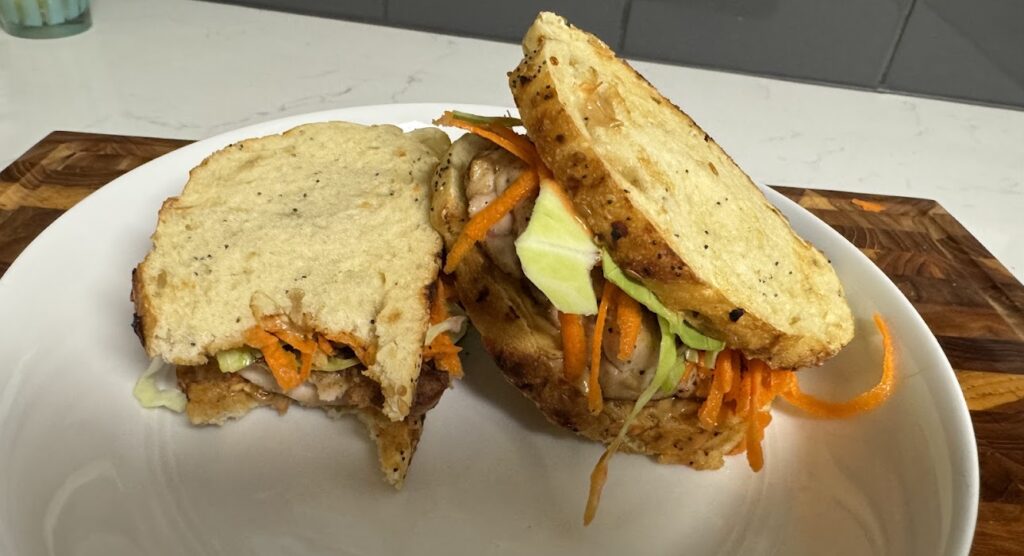
Time: 30 min
Note: Ordinarily I’d put exact amounts and detailed instructions, but it’s a sandwich… let your spirit guide you!
Ingredients
- Chicken breast or thighs
- Unsalted butter
- Olive oil
- Red pepper flakes
- Everything seasoning bread
- Crunchy peanut butter (I tried smooth too, but you want the crunch)
- Carrots, julienned
- Bean sprouts (or shredded cabbage if you’re an expectant mother!)
- Ranch dressing
- Sriracha
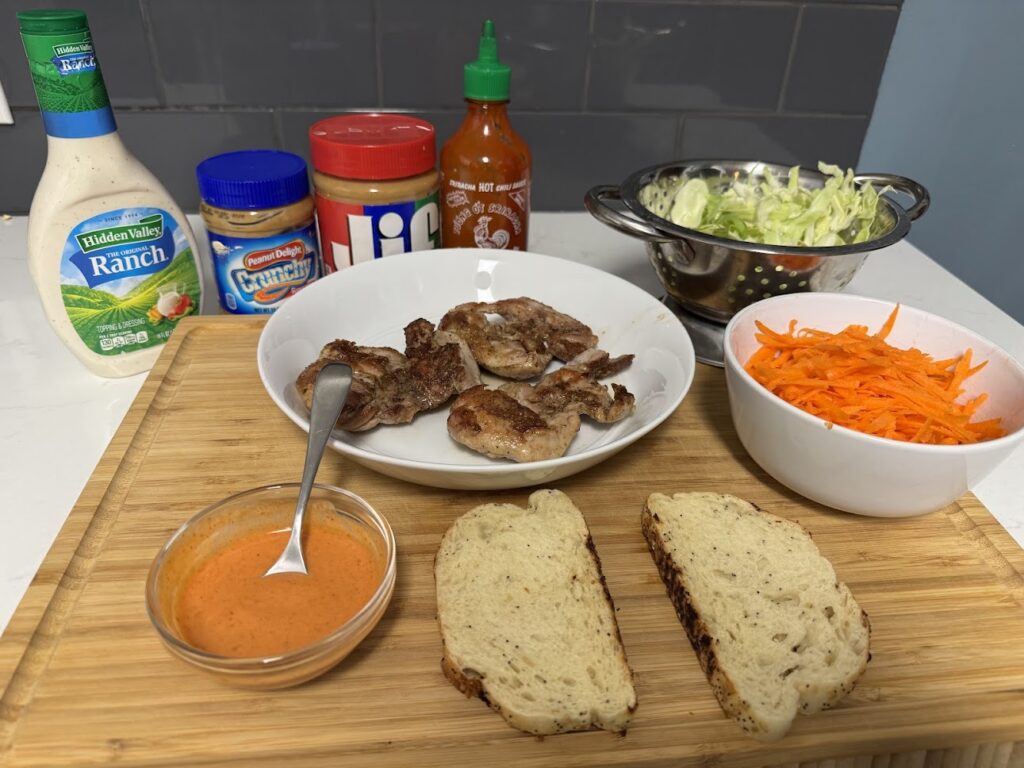
Instructions
- Prepare the chicken. I prefer to cook boneless skinless chicken thighs (more fat = more flavor) in a pan with a dab of butter and a dollop of olive oil and a pinch of red pepper flakes at a medium-low heat. Remove from the heat and set aside to rest a few minutes while you prepare the rest.
- Toast the bread and spread crunchy peanut butter on both sides—since you’re putting it on both sides, you can go with a relatively thin layer.
- In a small bowl, mix together your sriracha and ranch dressing, adjusting the sriracha to your desired heat level—don’t go too easy on the sriracha though, the heat cuts through the sweetness of the peanut butter.
- Depending on your choice of chicken, either cut it into strips and arrange on the bread or place the full piece of meat on it.
- Layer on a handful of julienned carrots.
- Layer on a handful of bean sprouts. If you are an expectant mother or don’t care for bean sprouts, you can use shredded cabbage instead.
- Drizzle your sriracha ranch over the sprouts/cabbage.
- Top with the second piece of bread and enjoy the sweet, savory, and spicy goodness!
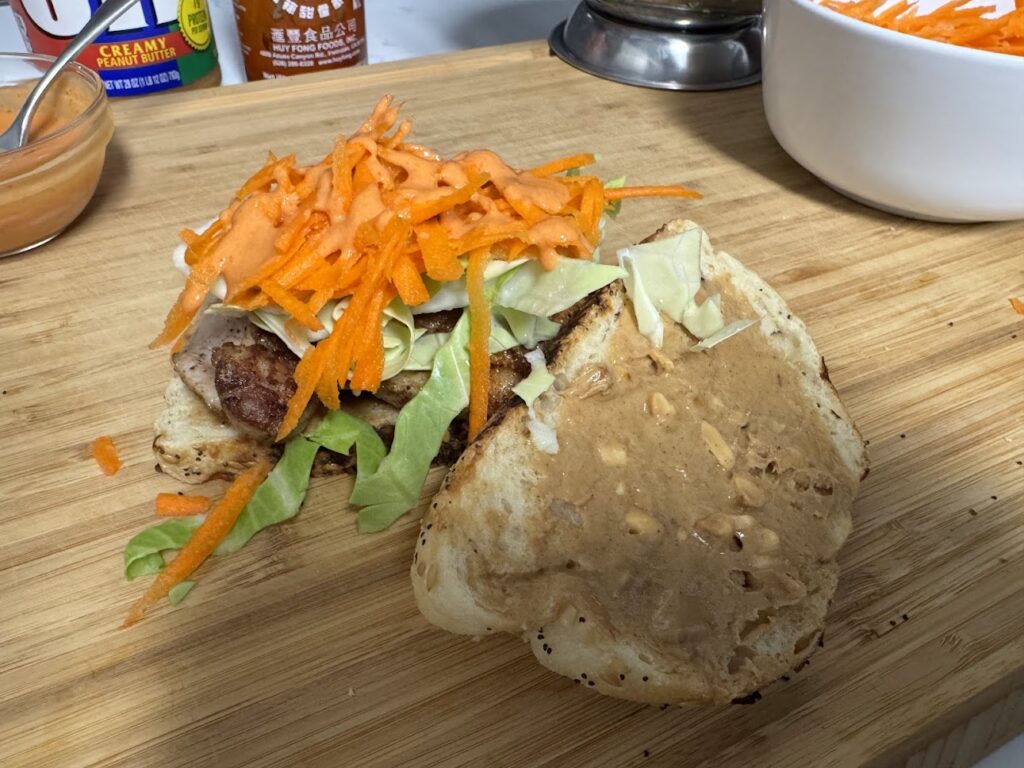
This was layered poorly. Add the carrots, then the sprouts/cabbage, so your sriracha ranch stands out better.












